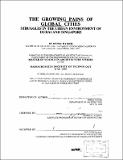| dc.contributor.advisor | Nasser O. Rabbat. | en_US |
| dc.contributor.author | Haider, Deeba, 1971- | en_US |
| dc.contributor.other | Massachusetts Institute of Technology. Dept. of Architecture. | en_US |
| dc.coverage.spatial | a-ts--- a-si--- | |
| dc.date.accessioned | 2011-11-01T19:44:34Z | |
| dc.date.available | 2011-11-01T19:44:34Z | |
| dc.date.copyright | 1999 | en_US |
| dc.date.issued | 1999 | en_US |
| dc.identifier.uri | http://hdl.handle.net/1721.1/66786 | |
| dc.description | Thesis (S.M.)--Massachusetts Institute of Technology, Dept. of Architecture, 1999. | en_US |
| dc.description | Includes bibliographical references (leaves 118-126). | en_US |
| dc.description.abstract | This Master's thesis explores the validity of current theories of globalization through the analysis of two prominent second level global cities, Dubai and Singapore. The hypotheses of global homogenization and hybridization are studied according to their prominence and influence on the architecture of the commercial, entertainment and central business districts of these two cities. | en_US |
| dc.description.statementofresponsibility | by Deeba Haider. | en_US |
| dc.format.extent | 126 leaves | en_US |
| dc.language.iso | eng | en_US |
| dc.publisher | Massachusetts Institute of Technology | en_US |
| dc.rights | M.I.T. theses are protected by
copyright. They may be viewed from this source for any purpose, but
reproduction or distribution in any format is prohibited without written
permission. See provided URL for inquiries about permission. | en_US |
| dc.rights.uri | http://dspace.mit.edu/handle/1721.1/7582 | en_US |
| dc.subject | Architecture. | en_US |
| dc.title | The growing pains of global cities : struggles in the urban environment of Dubai and Singapore | en_US |
| dc.type | Thesis | en_US |
| dc.description.degree | S.M. | en_US |
| dc.contributor.department | Massachusetts Institute of Technology. Department of Architecture | |
| dc.identifier.oclc | 43627272 | en_US |
